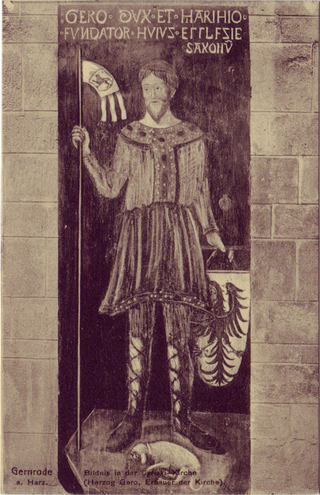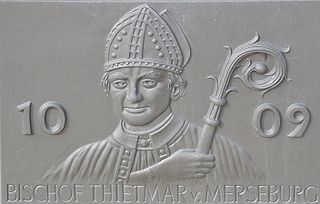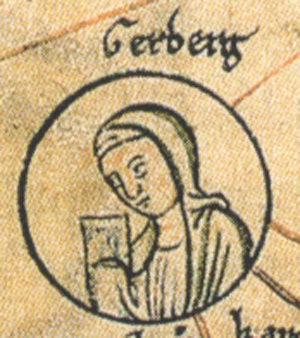Related Research Articles

Gernrode is a historic town and former municipality in the Harz District, in Saxony-Anhalt, Germany. Since 1 January 2014, it has been part of Quedlinburg. It was the seat of the former Verwaltungsgemeinschaft of Gernrode/Harz.

Gero I, sometimes called the Great, was a German nobleman who ruled an initially modest march centred on Merseburg in the south of the present German state of Saxony-Anhalt, which he expanded into a vast territory named after him: the marca Geronis. During the mid-10th century, he was the leader of the Saxon Ostsiedlung.

Thietmar, Prince-Bishop of Merseburg from 1009 until his death in 1018, was an important chronicler recording the reigns of German kings and Holy Roman Emperors of the Ottonian (Saxon) dynasty. Two of Thietmar's great-grandfathers, both referred to as Liuthar, were the Saxon nobles Lothar II, Count of Stade, and Lothar I, Count of Walbeck. They were both killed fighting the Slavs at the Battle of Lenzen.

Hermann Billung was the margrave of the Billung March from 936 until his death. The first of the Saxon House of Billung, Hermann was a trusted lieutenant of Emperor Otto I.

Gerberga of Saxony was the queen of France by marriage to Louis IV of France between 939 and 954. She ruled as regent during the minority of their son Lothair in 954–959.

Bernard I was the Duke of Saxony between 973 and 1011, the second of the Billung dynasty, a son of Duke Herman and Oda. He extended his father's power considerably.

The Battle on the Raxa river was fought on 16 October 955 over control of the Billung march between the forces of Otto I of Germany allied with the Rani tribe on one side, and the Obotrite federation under Nako and his brother Stoigniew with their allied and tributary Slav neighbours on the other. The Raxa river is identified with either the Recknitz or the Elde river. The German victory over the Slavs followed up on the August victory at the Lechfeld over the Magyars and marked the high point of Otto's reign.

Gernrode Abbey was a house of secular canonesses (Frauenstift) in Gernrode in what is now Saxony-Anhalt, Germany. Gernrode was founded in 959 and was disestablished in the seventeenth century. In the Middle Ages the abbey was an Imperial abbey, which had the status of imperial immediacy, and an Imperial State. In the early modern period, the abbey was part of the Upper Saxon Circle.

Adelaide I, a member of the royal Ottonian dynasty was the second Princess-abbess of Quedlinburg from 999, and Abbess of Gernrode from 1014, and Abbess of Gandersheim from 1039 until her death, as well as a highly influential kingmaker of medieval Germany.

Saint Cyriakus is a medieval church in Gernrode, Saxony-Anhalt, Germany. It is one of the few surviving examples of Ottonian architecture, built in 959/960–965 by Margrave Gero, although it was restored in the 19th century. From its foundation until 1614, Saint Cyriakus was the collegiate church of the Abbey of Gernrode, also founded by Margrave Gero. The church and the abbey became Protestant in the mid-sixteenth century, and the church is now used by the Protestant community of Gernrode.

The Counts of Stade were members of the Saxony nobility beginning in the 10th century. Stade had developed since the 8th century as a principal center of trade and communications. The Counts of Stade created their domain between the lower Elbe and Weser rivers. They extended their power northwards with the acquisition of Dithmarschen in the 11th century. They became the Margraves of the Nordmark in 1056. There is also a close political and familial relationship between the Counts of Stade and the Counts of Walbeck. The Northern March was replaced with the March of Brandenburg by Albert the Bear in the 12th century. The family of Counts of Stade is referred to as the House of Udonids.
Lothar II (874-929), Count of Stade, son of Lothar I, Count of Stade, and Oda of Saxony, daughter of Liudolf, Duke of Saxony. Lothar was the great-grandfather of Thietmar of Merseburg, and is frequently confused in genealogical sources with Thietmar’s other great-grandfather of the same name who was Count of Walbeck.
Henry I the Bald was the Count of Stade. He was the son of Lothar II, Count of Stade, and Swanhild of Saxony. Henry is recorded as a cousin of Otto I, Holy Roman Emperor, but their exact relationship remains a mystery. Henry was also appointed Count of Heilangau, the ancient capital of Stade, in 959.
Siegfried II, Count of Stade, was the youngest son of Henry I the Bald, Count of Stade, and his wife Judith von der Wetterau, granddaughter of Gebhard, Duke of Lorraine. He succeeded his brother, Henry as Count of Slade in 1016. He was captured by piates, but later escaped.
Gero was a Count of Alsleben, conjectured to be the son of Siegfried and therefore grandson of Gero the Great. If so, his mother was Hedwig, daughter of Wichmann the Elder. Gero was the brother of Tetta, who established a monastery at Alsleben in his name. Thietmar of Merseburg, whose Chronicon is the major source of information here, refers to Gero as a Count in Northern Thuringia and Morzani. Gero was married to Adela of an unknown family. Gero and Adela had one daughter, Adela of Alsleben, who married Siegfried II, Count of Stade. No other counts of Alsleben are recorded until the 12th century.
Adela of Hamaland, was countess of Hamaland in the Netherlands in about 973–1021. She was also the regent of Renkum in circa 983–?, likely as regent for her son Dirk of Renkum. Her claim on the inheritance of her father caused a conflict with her sister Liutgard of Elten, which lasted from 973 until 996. She first married Count Immed of Renkum, the father of her son, and later Count Balderik of Hamaland, whom she made her co-regent by marriage.
Hatheburg was the first wife of Henry the Fowler, later king of East Francia (Germany). After their marriage was dissolved, Hatheburg became abbess of a convent.

Oda of Meinersen was the abbess of Gernrode (r.1248-1260).
Gerhard of the Moselle, Count of Metz and possibly of Alsace, was a Lotharingian noble active in the early 11th century. He was a key figure within an alliance of Lotharingian nobles who were seen as opponents of Henry II, Holy Roman Emperor. This also put him in constant conflict with the king's loyal representatives in Lotharingia, his relatives in the family known to historians as the House of Ardenne–Verdun. Henry II was Gerhard's brother-in-law, as they had both married daughters of Count Sigfried, the ancestor of the counts of Luxembourg. Sigfried was also in the Ardenne dynasty, though his family came to be opposed to his Verdun cousins.
References
- C. Warnke, 'Das Kanonissenstift St. Cyriacus zu Gernrode im Spannungsfeld zwischen Hochadel, Kaiser, Bischof und Papst von der Gründung 961 bis zum Ende des Investiturstreits 1122,' in I. Crusius, ed., Studien zum Kanonissenstift (= Veröffentlichungen des Max-Planck-Instituts für Geschichte. Bd. 167 = Studien zur Germania Sacra. Bd. 24). (Vandenhoeck & Ruprecht, Göttingen 2001), ISBN 3-525-35326-X, S. 201–274
- Reuter, Timothy. Germany in the Early Middle Ages 800–1056. New York: Longman, 1991.
- W. Glocker, Die Verwandten der Ottonen und ihre Bedeutung in der Politik.
- O. von Heinemann, Geschichte der Abtei und Beschreibung der Stiftskirche zu Gernrode (H. C. Huch, Quedlinburg 1877).
- M. Giese, ed., Die Annales Quedlinburgenses, MGH Script. rer. Germ., 72 (Hannover, 2004).
- Thietmar of Merseburg, Chronicon, ed. R. Holtzmann MGH SS NS 9 (Berlin, 1935).
- R. Kellermann and G. Kellermann, 'Heiliger Teich', in Chronik der Stadt Gernrode, Gernroder Kulturverein Andreas Popperodt e.V. 2013.